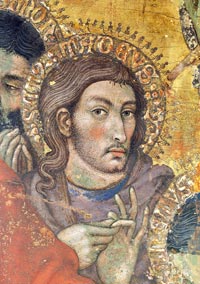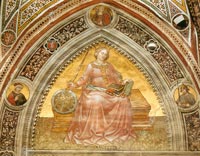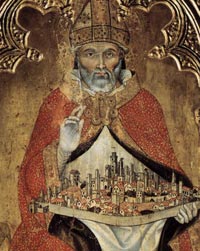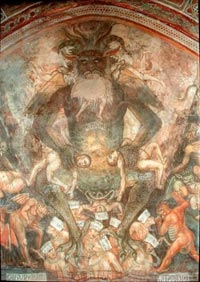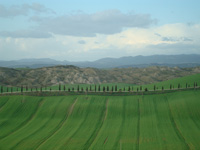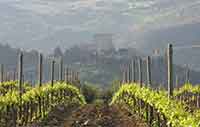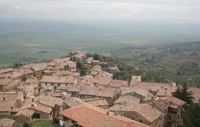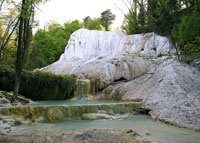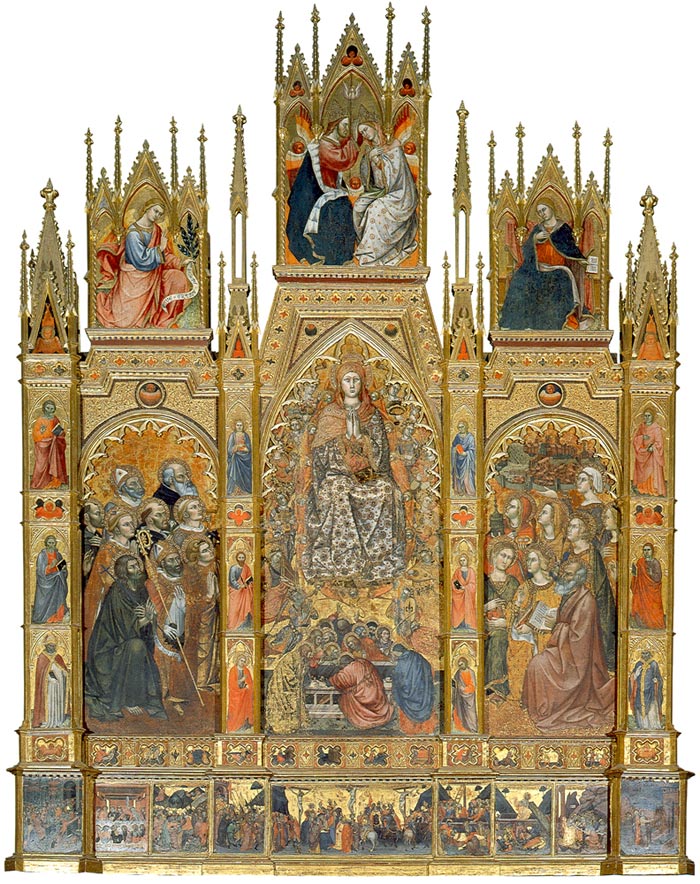 |
|
Assumption of the Virgin, painted in 1401, is situated in the 16th century Duomo of Santa Maria dell'Assunta at Montepulciano |
|
Taddeo di Bartolo |
| Taddeo di Bartolo (1362 or 1363 – August 26, 1422), also known as Taddeo Bartoli, was an Italian painter of the Sienese School during the early Renaissance. He was active in Pisa, Perugia, San Gimignano, and Volterra, his native city. He is among the artists profiled in Vasari's Le Vite delle più eccellenti pittori, scultori, ed architettori (in English, Lives of the Most Excellent Painters, Sculptors, and Architects). |
||
Taddeo di Bartolo was born in Siena. Much of his early work was in Pisa, where he was responsible for the frescoes of Paradise and Hell in the Cathedral there, and for paintings in the Palazzo Pubblico and the church of San Francesco. Taddeo's Madonna with Child, Four Angels and Saint John the Baptist and Saint Andrew may be seen in the Oratory of the Company of Saint Catherine of the Night, at Santa Maria della Scala, Siena. He also painted allegories and figures from Roman history (1413–14), and the Funeral of the Virgin (1409) at the Palazzo Pubblico in Siena. A Madonna and Child (c. 1400), painted with tempera and oil on a panel, is located in the Wadsworth Atheneum. Another Madonna and Child is in the collection of the Museum of Fine Arts, San Francisco, California, and yet another Madonna and Child is housed in the Musée du Petit Palais, Avignon, France. Taddeo di Bartolo died at Siena at about age 60. |
||
| The Pallazzo Publicco in Siena |
||
| Restoration of the republic after 1404 enabled the Priors towards an extensive embellishment of the Pallazzo Publico. (...) Among the first of the commissions for the building was the redecoration of the chapel holding a Maesta from 1302 by Duccio and located next to the room in which Simone Martini had painted his Maesta. In 1406-07 Taddeo di Bartolo (1362/63 Siena-1422 Siena), perhaps a student of Bartolo di Fredi (see Fig. 5.17), decorated its walls with frescoes and scenes from the life of the Virgin, the city's patron saint. (...) In 1413-14 the Priors again turned to Taddeo di Bartolo to paint a cycle of paintings for the antechapel of the Palazzo Publico, a space that functioned as an important passage between other rooms of the palace. On one wall, shown in the picture benearth, Taddeo painted allegories of Justice and Magnanimity under the two arches. Beneath each he placed a figure from Roman history exemplifying the concept. Below Justice (at left) there are Cicero, M. Porcius Cato, and P. Scipio Nasica; below Magnanimity (at right) Curius Dentatus, Furius Camillus, and Scipio Africanus. Each group of Roman heroes is labeled with an inscription in Latin, and each figure bears a further Latin Inscription below his feet. The inscriptions between M. Curius Dentatus and F. Furius Camillus claim them as founders of Siena, while others under Cicero and Cato speak of their fight for liberty and justice. [1] |
||
Madonna and Child, with Four Angels, St. John the Baptist, St. Andrew, dated 1400, by Taddeo di Bartolo, Oratory of the Company of Saint Catherine of the Night, Santa Maria della Scala, Siena. Besides the numerous paintings, carvings, reliquaries and decorations, the company conserves a beautiful table by Taddeo di Bartolo portraying the Madonna with Child, Four Angels and Saint John the Baptist and Saint Andrew, dated 1400 |
||
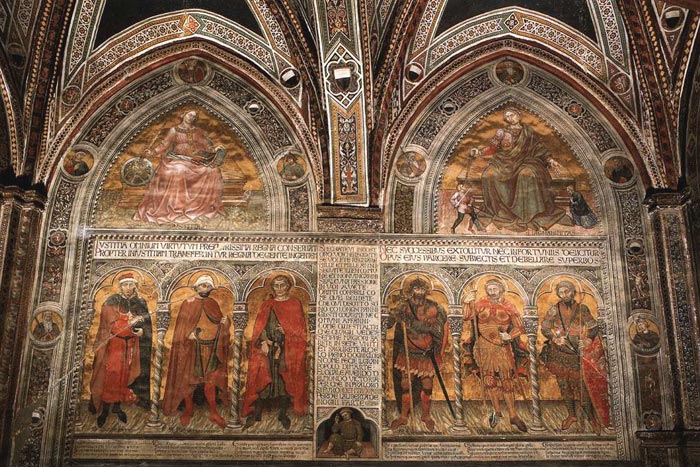 |
||
Taddeo Di Bartolo, Allegories and figures from Roman History, detail of the adulterers and The Lustful, 1413-14, fresco, 270 x 320 cm (each lunette) Palazzo Pubblico, Siena |
||
The Allegories of Justice and Magnanimity (1413-14), Justice with Cicero, M. Porcius Cato, and P. Scipio Nasica and Magnanimity with Curius Dentatus, Furius Camillus, and Scipio Africanus, were commissioned by the Priors from Taddeo di Bartolo for the Antechapel in Palazzo Publico in Siena. On one wall, shown in this picture, Taddeo painted allegories of Justice and Magnanimity under the two arches; beneath each he placed a figure from Roman history exemplifying the concept. Each group of Roman heroes is labeled with an inscription in Latin, and each figure bears a further Latin Inscription below his feet. The inscriptions between M. Curius Dentatus and F. Furius Camillus claim them as founders of Siena, while others under Cicero and Cato speak of their fight for liberty and justice.
|
||
| At the Collegiata di San Gimignano |
||
At the Collegiata di San Gimignano, Taddeo painted a fresco depicting the Last Judgment. A painting by Taddeo of Saint Gimignano holding the town in his lap may be seen at the Museo Civico there.
|
||
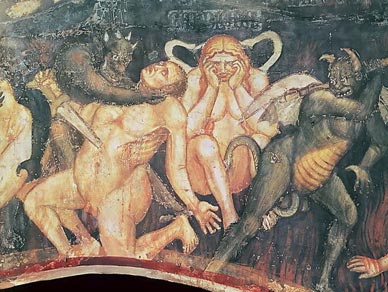 |
 |
|
Taddeo Di Bartolo, The Last Judgement, detail of the adulterers and The Lustful, c.1394,
San Gimignano, Collegiata |
||
| Vasari, Lives of the most Eminent Painters, Sculptors and Architects, Vol 2, Taddeo di Bartolo Madonna and Child, with Four Angels, St. John the Baptist, St. Andrew, dated 1400, by Taddeo di Bartolo, Oratory of the Company of Saint Catherine of the Night, Santa Maria della Scala, Siena. Website of Santa Maria della Scala, Siena, Itay. [1] John T. Paoletti, Gary M. Radke, Art in Renaissance Italy, 2005, pp 120-122. "Restoration of the republic after 1404 enabled the Priors towards an extensive embellishment of the Pallazzo Publico. (...) Among the first of the commissions for the building was the redecoration of the chapel holding a Maesta from 1302 by Duccio and located next to the room in which Simone Martini had painted his Maesta. In 1406-07 Taddeo di Bartolo (1362/63 Siena-1422 Siena), perhaps a student of Bartolo di Fredi (see Fig. 5.17), decorated its walls with frescoes and scenes from the life of the Virgin, the city's patron saint. (...) turned to Taddeo di Bartolo to paint a cycle of paintings for the antechapel of the Palazzo Publico, a space that functioned as an important passage between other rooms of the palace. The Priors thought this space important enough to assign Pietro de' Pecci, a lawyer and teacher in Siena, and Cristoforo di Andrea, the city's employs earlier conventions of spatial organization and figural composition. The way Taddeo truncates the faces of the apostles behind the bier indicates that he is sometimes interested in naturalistic observation. Yet none of the apostles seems to be actually bearing the weight of the bier, their wiry outline and sharp, angular poses are stock features in Taddeo's work. Along with the stylized or blank backgrounds in the frescoes these features would have givebn the decorative program of the city hall a stylistic consistency spanning over a century. (...) On one wall Taddeo painted allegories of Justice and Magnanimity under the two arches; beneath each he placed a figure from Roman history exemplifying the concept. Each group of Roman heroes is labeled with an inscription in Latin, and each figure bears a further Latin inscription." |
|
|
|
||||
Podere Santa Pia |
Val d'Orcia |
|||
| Monte Cucco wine region | Cipresses between Montalcino and Pienza | Montalcino | ||
Siena, duomo |
Florence, Duomo
|
Bagni San Filippo |
||
|
||||

